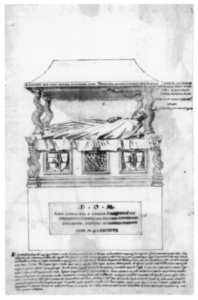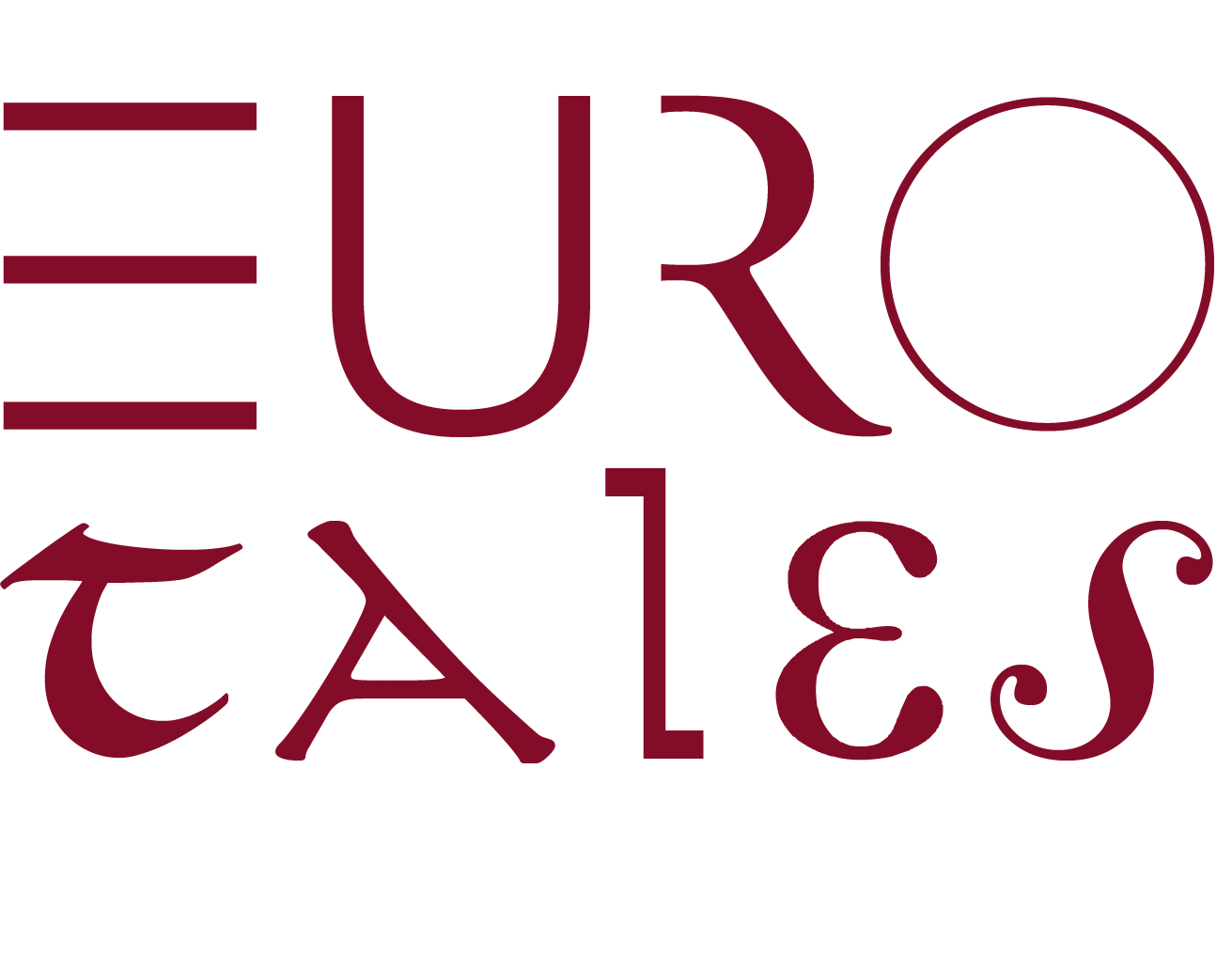Inscriptions
Extant Inscription: D. O. M. / ADAM.ANGLO.T(I)T(VLI)] S(ANCT)Æ CÆCILIÆ.PRÆSBYTERO / CARDINALI.EPISCOPATVS LEONDINENSIS PERPETVO/ ADMINISTRATORI.INTEGRITATE. DOCTRINA/ ET.RELIGIONE.PRÆSTANTI / OBIT.DIE.XV.AVCVSTI MCCCXCVIII D.O.M., stand for Deo Optimo Maximo Lost Inscription (from lost canopy): + Artibus iste pater famosus in omnibus Adam / theologus summus cardiquenalis erat / Anglia cui patriam titulum dedit ista beate / edes Cecilie morsque suprema polum / anno M CCC LXXXX VII mense septembris XV
Extant Inscription: In the Name of God [Deo Optimo Maximo]
Description

 This monument with its Latin inscription provides a trace of a late 14thc English member of the papal curia in both Avignon and Rome; it can stand for both the multinational and mutilinguistic nature of papal courts, and for the English, Latin and French language culture in which Cardinal Adam Easton lived, and his encounters with the Hebrew language and with a speaker of a Romance language, Gascon; it alerts us to his life, travels and works, which include what is perhaps the first English work of Biblical translation from Hebrew into Latin. Born circa 1330 in Easton, Norfolk (UK), where today a representation of the cardinal decorates the Easton village signpost, Adam Easton, his tombstone and its inscription provide evidence of English residents in Rome in this period.
This monument with its Latin inscription provides a trace of a late 14thc English member of the papal curia in both Avignon and Rome; it can stand for both the multinational and mutilinguistic nature of papal courts, and for the English, Latin and French language culture in which Cardinal Adam Easton lived, and his encounters with the Hebrew language and with a speaker of a Romance language, Gascon; it alerts us to his life, travels and works, which include what is perhaps the first English work of Biblical translation from Hebrew into Latin. Born circa 1330 in Easton, Norfolk (UK), where today a representation of the cardinal decorates the Easton village signpost, Adam Easton, his tombstone and its inscription provide evidence of English residents in Rome in this period.
A native speaker of English, Benedictine monk Adam Easton’s education in the Cathedral Priory at Norwich and at Oxford would have been conducted almost entirely in Latin, and he would have had a good knowledge of French, that was still the language of high culture and officialdom in England. His surviving letters and his books were all written in Latin, and his much appreciated sermons to the Benedictine community in the Cathedral Priory of Norwich (where he preached from 1356- c.1364) would most likely have been delivered in clerical Latin, too, even though sermons to the laity were given in English. In 1368 he went to Avignon as part of the household and working team of Simon Langham, Cardinal of San Sisto Vecchio in Rome and ex Archbishop of Canterbury. While always able to communicate in Latin with other clerics and international visitors, in daily speech he would have communicated in English with his compatriots, and French with Frenchmen. We know, however, that he spoke English to the Gascon Roger Foucault, Dean of St. Emilion (Harvey 197). St Emilion was part of a region of France that belonged to the English crown at that time (Thomson). Foucault’s use of English may reflect the personal preference of Foucault; it may also reflect a subtle appeal to a fellow subject of the English crown ( the French and English monarchs were at war), or to a friend who could support him in ongoing Church politics (Foucault had allied himself with the losing side of the Great Schism of the Catholic church); or it could be that both preferred English since Foucault did not speak the Langue d’oil (French) used by English speakers of French, and Easton was unfamiliar with Gascon. (Gascon is a variety of Romance, and a variety of Occitan, whose noticeable differences arise from it being part of the Basque dialect continuum). We have records of Easton travelling, with longer or shorter stays at each place, to and from Avignon, Westminster and Norwich, Montefiascone, Paris, Freton (in Utrecht), Rome, and Genoa. While in Avignon, in the 1370s, he set about learning Hebrew and discussed and debated Biblical issues with Jewish scholars from the famously learned Ghetto there. He wrote a translation of the Bible from Hebrew into Latin, attempting an improvement upon S Jerome’s translation, the widely used Vulgate Bible; but this manuscript book was lost in the 16th c. when it was stolen from Robert Wakefield, the first lecturer in Hebrew at Cambridge.
Storage
The insription on the canopy is lost and recorded from a 17th century drawing only. The extant inscription on a panel in the pedestal to the tomb is clear but somewhat worn in places
Bibliography
Bolgia, Claudia, Between Tradition and Innovation: the sepulchral monument of Adam Easton at S. Cecilia in Trastevere, «Miriam Wendlyng (ed). Cardinal Adam Easton (c. 1330-1397), Monk, Scholar, Theologian, Diplomat», Amsterdam, Amsterdam University Press, 2020, 175-206
Harvey, Margaret, 2009, The English in Rome 1362-1420, Cambridge, Cambridge University Press, 2009
Kreytenberg, Gert, Das Grabal Für Kardinal Adam Easton in Santa Cecilia in Trastevere und seine Bildhauer Giovanni D’Ambrogio und Lorenzo di Giovanni aus Florenz, «Mitteilungen des Kunsthistorischen Institutes in Florenz, 53. 2/3», 2009, 197-216
Thomson, John A. F., The Transformation of Medieval England 1370-1529., London, Routledge, 2014
Links
Transcription author: Gert Kreytenberg (canopy); Margaret J-M Sonmez (panel)
Card author: Margaret J-M Sonmez
Translation author: Claudia Bolgia (canopy); Nadia Cannata (panel)
Publication Date: 2021-11-01
Adam Easton tomb
Trace type: signing up
Dating: 1400-1600
Year: 1400-1405
Language: Latin
Writing systems: Latin alphabet

